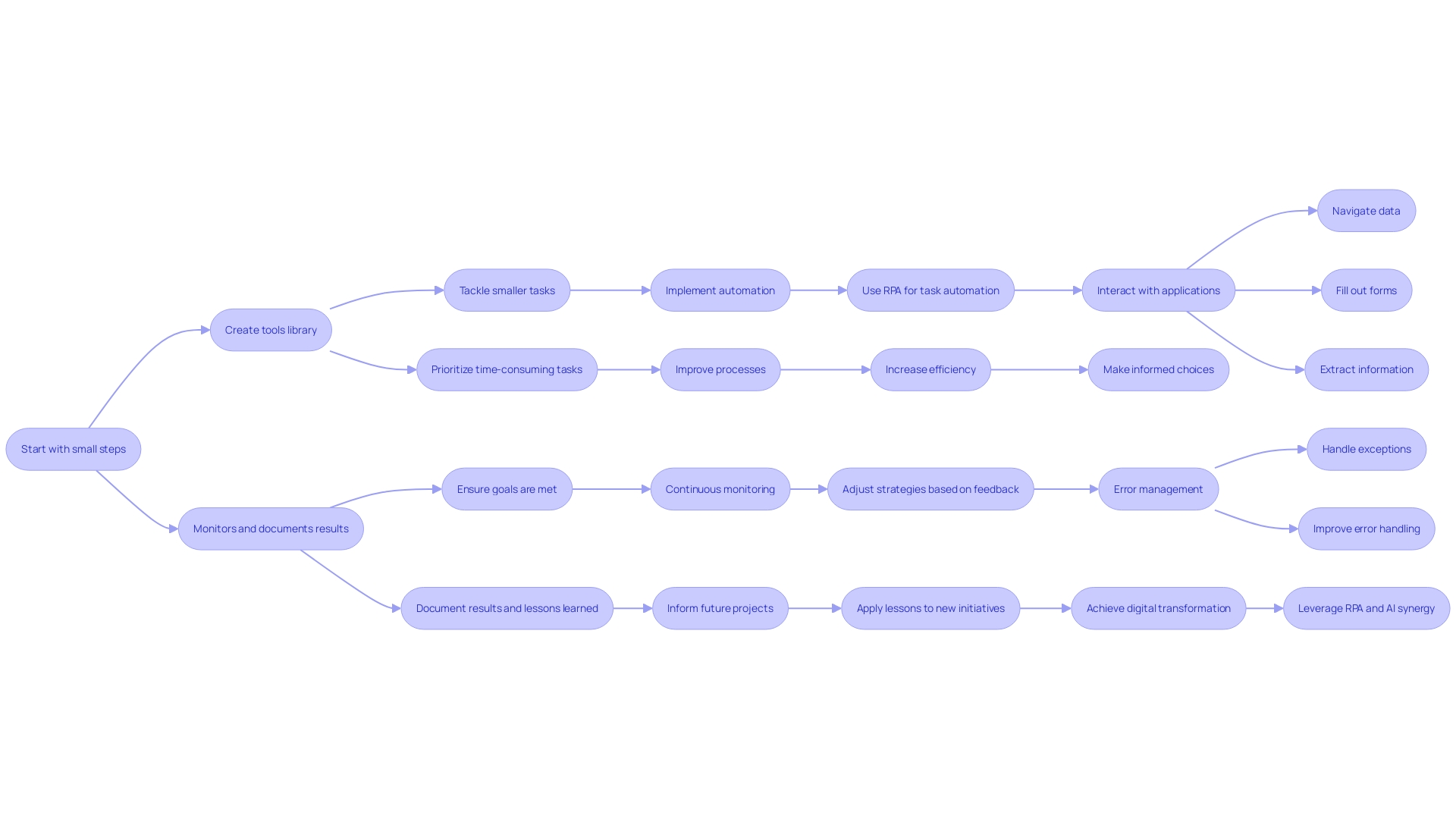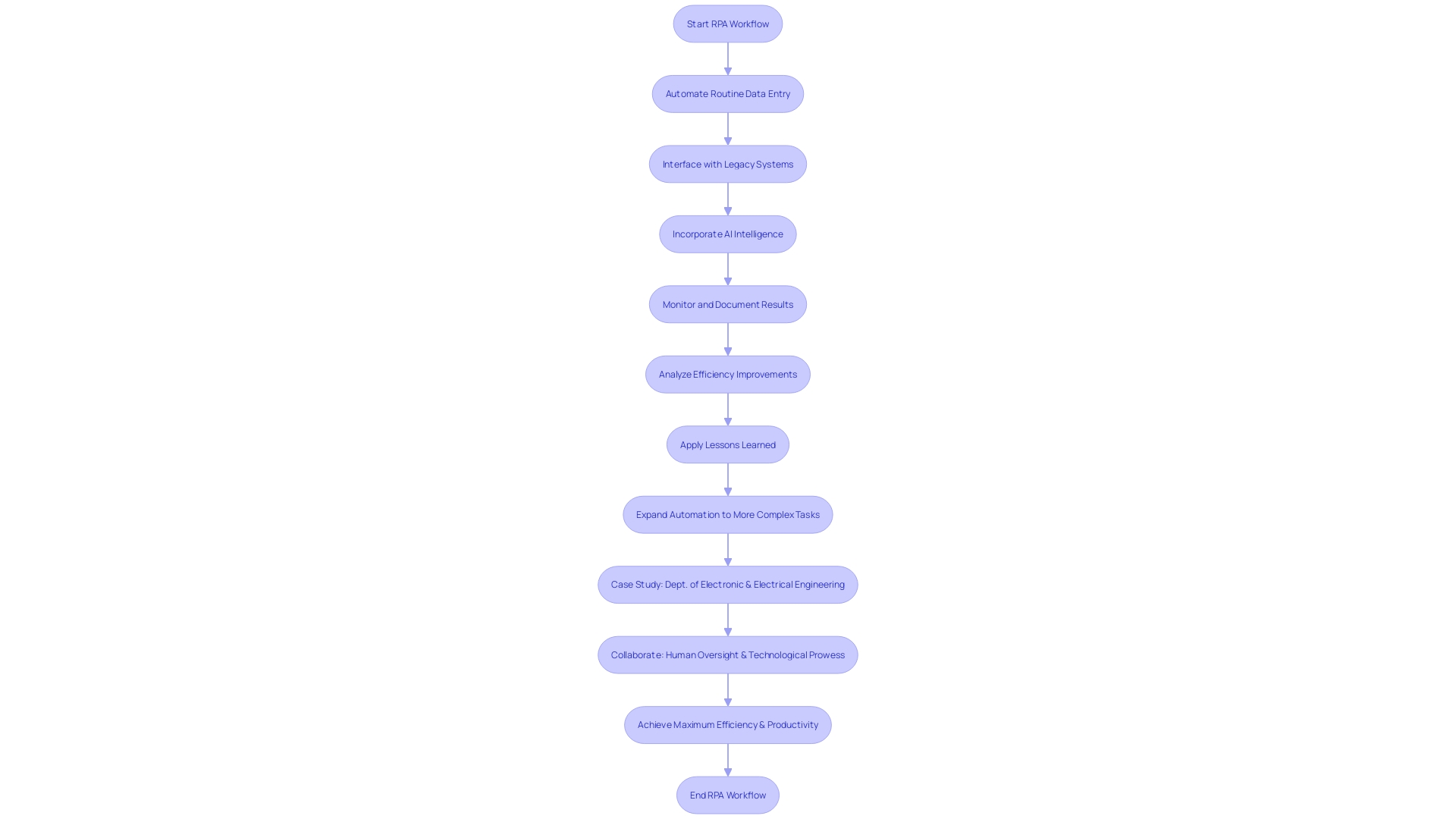Introduction
Robotic Process Automation (RPA) is transforming the way businesses operate, revolutionizing routine tasks through the deployment of software bots. These bots, designed to replicate human actions, engage with digital environments and execute functions with unparalleled speed and precision. RPA goes beyond simple tasks, bridging the gap between systems and enabling seamless operations across platforms.
This article explores the capabilities of RPA, its key components, and the benefits it offers in terms of operational efficiency, cost savings, and compliance. By coupling RPA with AI, businesses can make data-driven decisions and gain a competitive edge in the digital landscape. The implementation of RPA requires careful planning and consideration of factors such as process automation, integration costs, and scaling strategies.
Through intelligent automation, RPA empowers businesses to enhance productivity, streamline processes, and foster growth, ultimately delivering improved customer satisfaction and loyalty.
What is Robotic Process Automation (RPA)?
Robotic Process Automation, commonly known as RPA, is revolutionizing the way businesses operate by deploying software robots to perform routine, monotonous tasks. These automated systems are created to imitate human actions, thereby enabling them to interact with digital environments and perform tasks such as data manipulation, report generation, and routine communications with unparalleled speed and accuracy.
These innovations are not limited to simple tasks. Progress in technology enables these bots to handle intricate workflows, connecting different systems and enabling smooth operations across platforms. The result is a significant reduction in the need for manual oversight, leading to fewer human errors and a marked increase in operational efficiency.
For instance, consider the transformative impact of RPA within the global hotel industry as illustrated by the partnership between Louvre Hotels Group and RobosizeME. The implementation of RobosizeME’s technology has transformed rate code maintenance, resulting in a significant decrease in man-hoursâsaving 188 hours monthly on rate code headers and 386 hours on rate code details.
Furthermore, the Korea Institute of Machinery and Materials (KIMM) has recently developed an AI technology that enhances robot functionality in manufacturing. This Large Language Model (LLM)-based technology allows robots to interpret user commands, creating a more intuitive and efficient manufacturing process.
As organizations ponder the integration of RPA, leaders must consider various factors to ensure successful implementation. Queries regarding which processes are ready for mechanization and the anticipated cost and time consequences of embracing RPA are crucial. Companies are advised to start small, automating less complex tasks before progressing to more intricate systems, and to maintain diligent monitoring and documentation to measure success and inform future initiatives.
The journey towards digital transformation through intelligent automation is marked by both challenges and opportunities. By coupling RPA with AI, businesses not only streamline processes but also gain the ability to make more data-driven decisions, ultimately leading to enhanced productivity and a competitive edge in an ever-evolving digital landscape.
How RPA Works
Robotic Process Automation (RPA) functions as an efficiency catalyst, harnessing software robots that interact with interfaces of current applications in a manner similar to human users. By following established rules and instructions, RPA robots can skillfully navigate data, fill out forms, extract information from documents, and perform a wide range of tasks. The versatility of RPA allows for the training and deployment of bots across diverse systems, promoting a fluid integration with the company’s existing technological framework.
These software robots boast the capability of operating on a schedule, activating upon specific event occurrences, or being manually initiated, providing flexibility in their use. Integral to RPA are its error management features, which encompass exception handling and audit trails, fortifying the accuracy and adherence to compliance within its operations.
From the perspective of leadership, the decision to implement RPA should be underpinned by a thorough understanding of the potential enhancements and the challenges that accompany technological modernization. Determining which manual processes are ready for mechanization, identifying the inefficiencies that RPA can address, and estimating the integration costs are crucial steps in the path towards automated operations.
Looking at case studies like NHS’s digital assurance process, one observes the methodical evaluation of technology requests ensuring security, appropriateness, and compliance. This reflects the critical nature of due diligence before adopting new digital technologies. For example, the NHS’s Digital Service Team conducts an initial assessment of technology requests to verify whether the technology aligns with existing solutions or introduces new, necessary functionalities.
In the broader market, events like the Consumer Electronics Show (CES) exhibit the remarkable speed of technological advancement, with companies like Boston Dynamics showcasing the latest in robotics, illustrating the potential of mechanization in diverse sectors. Furthermore, OODA’s team of experts highlights the need for advanced intelligence and strategy in managing digital transitions, underscoring the importance of strategic planning in the adoption of RPA.
The implementation of RPA has historical precedence; automation has long been the foundation of commercial progress, from the water wheel to AI. The evolution signifies not only an elevation in efficiency but also the necessity of human oversight to ensure the ongoing stability and refinement of these systems. As enterprises, especially small organizations, aim to expand their operations, RPA can offer substantial assistance by improving customer satisfaction through fast and dependable service, thereby strengthening customer loyalty.
While the allure of a sweeping technological overhaul can be tempting, evidence suggests that an incremental strategy of experimentation and scaling is more effective. This approach, backed by strong stakeholder support, sufficient investment, and adept change management, can result in significant gains. For instance, a semiconductor foundry’s targeted digitization efforts led to faster time-to-market, cost reductions, and improved quality by standardizing best practices and enhancing project management.

Key Components of RPA
Robotic Process Automation (RPA) stands at the forefront of business process innovation, offering a suite of components that work harmoniously to streamline operations. At the core of RPA lies the software platform, a robust foundation that facilitates the creation, management, and deployment of automation workflows, empowering bots—our digital workforce—to execute tasks with precision. These automated systems, similar to dedicated employees, can either work together with human users (attended) or carry out tasks autonomously (unattended), demonstrating their versatility in their application.
The coordination of these automated systems is carried out through the Control Room, a sophisticated command center that offers real-time insights into system performance, enabling precise management and optimization of workflows. In the Development Studio, the design of mechanization is crafted, offering a user-friendly interface for designing elaborate processes that define the operational logic of digital assistants.
The orchestrator component ensures that multiple bots work in concert, elegantly navigating complex tasks and maintaining system integrity when exceptions arise. This combination of elements not only improves operational effectiveness but also aligns with strategic objectives, as demonstrated by GrayMatter Robotics’ mission to enhance human productivity through AI-driven technology.
Incorporating RPA into an organization’s ecosystem is a strategic endeavor that necessitates thoughtful planning and preparation. Key considerations include identifying manual processes ripe for automation, analyzing inefficiencies to be addressed, and evaluating the integration costs. A thorough comprehension of RPA’s capabilities, as demonstrated by its influential role in data entry, transaction processing, and customer service, enables leaders to make informed decisions that drive innovation forward.
Recent advancements in AI, as seen in the UK’s public transport system and TSA’s facial recognition program, underline the transformative potential of technology in enhancing safety and operational efficiency while also raising important ethical considerations. Similarly, the use of robotics in conflict zones like Ukraine and Gaza signifies an evolution in military strategy and underscores the urgency for international dialogue on the subject.

Benefits of RPA
Robotic Process Automation (RPA) is revolutionizing the way businesses operate, providing a host of benefits that can dramatically enhance operational efficiency and productivity. RPA’s software automation works tirelessly, executing tasks with precision around the clock, which significantly speeds up processes that were once time-consuming when done manually. These automated systems meticulously adhere to established guidelines, virtually eliminating human error, thereby enhancing the accuracy and integrity of data.
Cost savings emerge as a direct result of RPA’s ability to automate routine tasks, reducing the need for additional personnel and allowing companies to reallocate resources towards more strategic, value-adding activities. With the scalable nature of RPA, organizations can adjust the number of bots in use to meet fluctuating demands, ensuring a responsive and agile operational model.
Furthermore, RPA aids in maintaining stringent compliance standards. It generates comprehensive logs of every task executed, guaranteeing that processes adhere to regulatory necessities and aiding enterprises in evading expensive penalties.
The practical application of RPA in healthcare, for instance, showcases its transformative potential. When clinicians request new digital technologies, a rigorous assessment is conducted to ensure security, appropriateness, and compliance. This process often reveals that the requested technology is already in use, highlighting the importance of thorough system reviews to avoid unnecessary duplication and optimize existing RPA solutions.
In the field of smart mechanization, RPA is no longer restricted to basic tasks. The integration of AI and generative AI has expanded its capabilities, allowing it to process unstructured data and complete more complex workflows. This collaboration between RPA and AI is propelling the digital transformation of organizations, resulting in well-informed decision-making and enhanced efficiency.
Successful implementation of RPA requires a strategic approach. Beginning with small tasks enables companies to slowly adjust to mechanization, while ongoing supervision and record-keeping of outcomes guarantee the accomplishment of goals. By creating a library of tools to support intelligent automation and focusing on customer satisfaction, businesses can leverage RPA to foster growth and maintain strong customer relationships, as evidenced by the significant revenue increases reported by companies that have embraced this technology.
Conclusion
Robotic Process Automation (RPA) is revolutionizing businesses by deploying software bots that replicate human actions, improving operational efficiency and streamlining processes. Coupling RPA with AI enables data-driven decision-making and a competitive edge in the digital landscape. Implementing RPA requires careful planning, considering factors like process automation, integration costs, and scaling strategies.
RPA functions as an efficiency catalyst, using software robots to interact with applications and execute tasks with precision. Versatile and adaptable, RPA integrates seamlessly with existing technological frameworks, ensuring accuracy and compliance through error management features.
The key components of RPA include the software platform, control room, development studio, and orchestrator. These components harmoniously streamline operations and empower bots to execute tasks accurately.
RPA offers numerous benefits, including increased operational efficiency, cost savings, and stringent compliance standards. By automating routine tasks and reallocating resources, businesses can achieve cost reductions and focus on strategic activities. RPA’s integration with AI expands its capabilities, enabling the processing of unstructured data and complex workflows.
Successful implementation of RPA involves starting with minor tasks and continuously monitoring and documenting results. By leveraging RPA, businesses can foster growth, maintain strong customer relationships, and drive digital transformation.
In conclusion, RPA is transforming businesses by revolutionizing routine tasks through software bots. Coupling RPA with AI empowers data-driven decision-making and a competitive edge. Implementing RPA requires careful planning and consideration of various factors.
RPA enhances operational efficiency, saves costs, and ensures compliance. By leveraging RPA, businesses can drive growth, maintain customer relationships, and achieve significant gains.
Take your business to the next level with RPA and drive digital transformation today!

